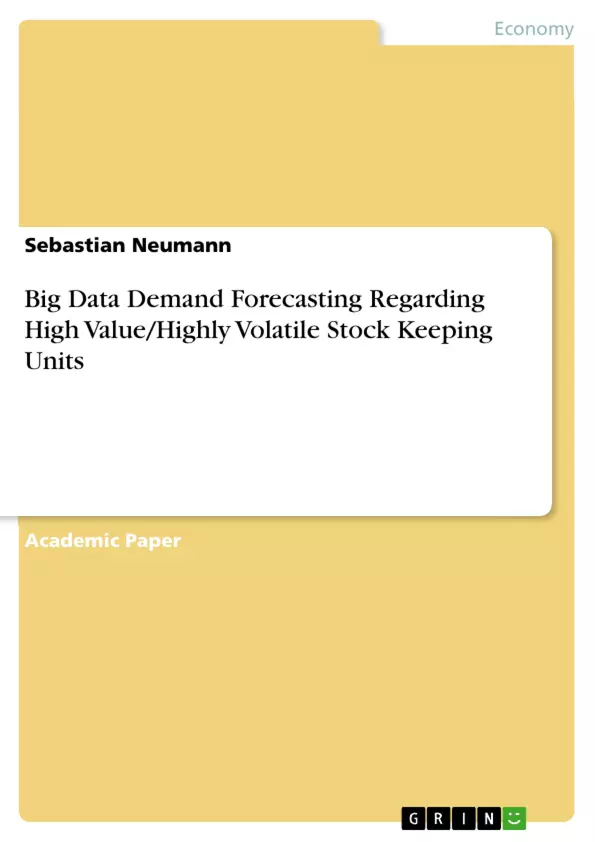This paper gives readers the possibility to brighten and deepen their knowledge in subjects which are closely related to Supply Chain Management.Predictive analytics, in the context of big data demand forecasting, is a revolutionary phenomenon in the modern world, and is expected to remain so in the foreseeable future. In this paper, the conditioning of big data, in the context of organizations that carry out a demand forecast, is differentiated into three parts. Accordingly, the procedure of data acquisition, data classification concepts, and forecasting methods are examined. The review of the literature has yielded an assessment method that supports demand planners to determine how big pools of data can be classified and utilized to carry out a forecast in a compatible manner. The case related application of the developed assessment method in organizations that forecast highly volatile stock keeping units with high monetary value was successful.
The following paper is subdivided into a total of six chapters. Accordingly, after the introductory chapter has shed light on the subject, further work on the topic will be conducted as follows: Chapter two will provide insights regarding the relationship between big data and the objective of this paper, by providing information about the acquisition of planning data. Within chapter three, different classification concepts are introduced considering the context of compatibility with specific forecasting methods of chapter four, respectively. This predominantly conducted literature review results in an assessment method that is applied in chapter five, where identified insights are considered in the context of different case studies. Lastly, chapter six states a brief conclusion about essential results found out in this paper.
Table of Contents
- Introduction
- Motivation and Background
- Objective and Outline of this Paper
- Acquisition of Big Data
- Classification Concepts
- VED Analysis
- FSN Analysis
- SDE Analysis
- HML Analysis
- XYZ Analysis
- ABC - XYZ Analysis
- Classification Synopsis
- Demand Forecasting Methods
- Qualitative Forecasting Methods
- Delphi Method
- Jury of Expert Opinion
- Market Survey
- Qualitative Forecasting Synopsis
- Quantitative Forecasting Methods
- Time Series Models
- Moving Average
- Exponential Smoothing
- Box-Jenkins
- Time-Series Forecasting Synopsis
- Causal Models
- Regression Models
- Econometrics Models
- ANN Models
- Causal Forecasting Synopsis
- Forecast Error Measures
- Contrasting Juxtaposition of Forecasting Methods and Classification Concepts
- Time Series Models
- Case Studies
- Application of Forecasting/Classification Compatibility Matrix
- Industrial Application
- Conclusion
- Contribution of this Study
- Managerial Implication
- Limitations and further Research
Objectives and Key Themes
This paper explores the use of predictive analytics for big data demand forecasting in the context of organizations managing high-value, volatile stock keeping units. The paper aims to establish a comprehensive assessment method that assists demand planners in classifying and utilizing large data sets for forecasting purposes.- Data conditioning methods for big data demand forecasting
- Classification concepts for effectively organizing large data pools
- A diverse range of forecasting methods, encompassing both qualitative and quantitative approaches
- The compatibility of forecasting methods and classification concepts
- Practical applications of the developed assessment method in real-world scenarios
Chapter Summaries
The introduction lays out the motivation and background for the study, emphasizing the significance of predictive analytics in the realm of big data demand forecasting. The paper aims to develop a methodology for effectively handling and utilizing large data pools for forecasting purposes. The second chapter delves into the acquisition of big data, outlining the processes involved in gathering and collecting data relevant for demand forecasting. Chapter three explores various classification concepts commonly employed in demand forecasting, including VED, FSN, SDE, HML, XYZ, and ABC-XYZ analysis. These concepts provide a framework for organizing and categorizing data based on various criteria. Chapter four presents an extensive review of demand forecasting methods, dividing them into qualitative and quantitative approaches. Qualitative methods include the Delphi method, jury of expert opinion, and market surveys. Quantitative methods encompass time series models, causal models, and forecast error measures. Chapter five showcases case studies demonstrating the practical application of the developed assessment method. It examines the compatibility between forecasting methods and classification concepts, highlighting successful implementations in real-world industrial settings.Keywords
This paper focuses on the intersection of predictive analytics, big data, and demand forecasting. Key themes include data conditioning, classification concepts, various forecasting methods, and their compatibility in practical applications. The paper explores techniques for effectively managing and utilizing large datasets to predict demand, particularly for high-value and volatile stock keeping units. - Qualitative Forecasting Methods
- Quote paper
- Sebastian Neumann (Author), 2020, Big Data Demand Forecasting Regarding High Value/Highly Volatile Stock Keeping Units, Munich, GRIN Verlag, https://www.grin.com/document/918406



